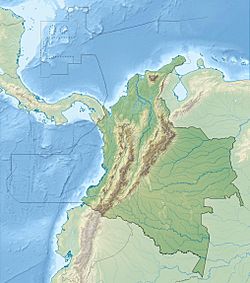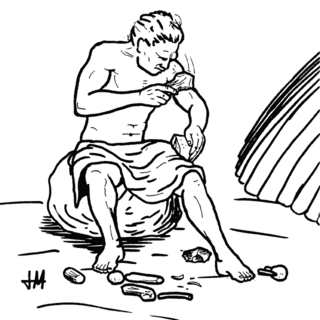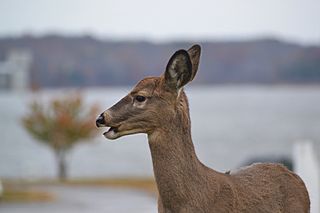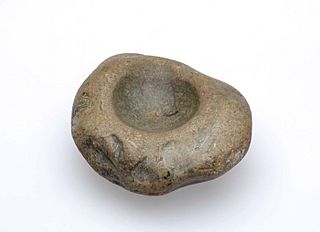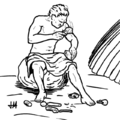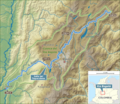Aguazuque facts for kids
| Location | Soacha, Cundinamarca |
|---|---|
| Region | Bogotá savanna, Altiplano Cundiboyacense, |
| Coordinates | 4°36′08″N 74°16′35″W / 4.60222°N 74.27639°W |
| Altitude | 2,601 m (8,533 ft) |
| Type | Open area settlement |
| Part of | Pre-Muisca sites |
| Area | 76 m2 (820 sq ft) |
| History | |
| Periods | Andean preceramic-Herrera |
| Cultures | Herrera |
| Site notes | |
| Archaeologists | Correal |
| Public access | Yes |
Aguazuque is an ancient place in Colombia. It is found in the western part of Soacha, a town in the Cundinamarca area. This site shows signs of people living there long ago.
These early people were mostly hunter-gatherers. This means they hunted animals and gathered plants for food. Later, some of them started to become simple farmers.
Aguazuque is on the Bogotá savanna, a flat highland area. It is near the Bogotá River, about 2,600 meters (8,530 feet) above sea level. The site is close to another old place called Tequendama and a lake called Lake Herrera.
Most of the things found at Aguazuque are from a time before pottery was used. These items are about 5,025 to 2,725 years old. The newer finds include pottery, showing a later period called the Herrera Period. It was a bit hard to date the very top layers because farming has disturbed the soil there.
At Aguazuque, archaeologists found many old human items. These include tools made of stone and bone. They also found remains of old fireplaces and lots of ancient foods. There were simple round houses and many burial sites for individuals and groups. In the newest layers, they found pieces of pottery.
This site is important because it shows how people changed. They went from being hunter-gatherers to starting to farm. It also shows a time when people moved out of caves. They began to live in open areas instead.
Archaeologist Gonzalo Correal Urrego has studied Aguazuque since 1986. He wrote a book about his findings in 1990.
Contents
What Does Aguazuque Mean?
The name Aguazuque comes from a large farm. This farm, called Hacienda Aguazuque, was built in the early 1600s. It was located west of the capital city, Bogotá.
A Look Back in Time
People have lived in the Altiplano Cundiboyacense for a very long time. The oldest proof of humans living here is from El Abra. This place is in Zipaquirá, Cundinamarca. At El Abra, stone tools were found. Scientists used carbon dating to find their age. They are about 12,500 years old.
Other early sites include Tibitó (11,400 years ago) and Tequendama (11,000 years ago). Later, people settled in places like Mosquera and Chía. Pottery from a later time was found near Lake Herrera. This period, from 800 BC to 800 AD, is called the Herrera Period.
From 800 AD until 1537 AD, the Muisca people lived here. They were one of the four big civilizations in the Americas. In 1537, the Spanish arrived and took over the area.
Soacha is now a very big city near Bogotá. It was also an important place for ancient settlements. Besides Aguazuque, other old sites have been found in Soacha. For example, in 2014, a large ancient town was found there. It had the remains of 2,200 people. More than 600 ceramic pots and other items were also discovered.
The name Soacha comes from the Muysccubun language. Súa means Sun, and chá means man.
Exploring Aguazuque
The ancient remains at Aguazuque were found in an oval-shaped area. This area is a bit raised and is west of the Bogotá River. Aguazuque is in the southwestern part of the Bogotá savanna. It is surrounded by higher hills, some reaching 2,850 meters (9,350 feet).
The weather here is cool, with an average temperature of 13°C (55°F). It does not rain as much here as in other parts of the Bogotá savanna. The ground at Aguazuque is made of old sandstones. The top layers of soil contain sand and clay. These came from an ancient lake called Lake Humboldt. There are also layers of volcanic ash.
Fossils of very large animals from the Ice Age were found nearby. These were dated to 20,000 years ago. The site itself is about 76 square meters (818 square feet) in size. Archaeologists dug down about 2 meters (6.6 feet) to find remains.
Tools and Objects
The stone tools found at Aguazuque are like those from El Abra and Tequendama. They were mostly made from a type of rock called chert. These tools included scrapers, knives, and tools for making holes. There were also grinding stones for preparing food.
Most of the tools came from nearby chert. Some tools were made from other rocks found farther away. Besides tools, many small pieces of rock were found. These were flakes left over from making the tools. About 60 to 70% of all rock pieces found were these flakes.
Other objects were made from bones and shells. These included beads, spear points, and more tools for scraping and making holes. Bone scrapers were very common, making up most of the bone tools found.
What They Ate: Plants and Animals
Archaeologists found remains of many animals at Aguazuque. These animals were part of the diet of the people living there. They ate mammals, reptiles, birds, fish, and even creatures like snails and crabs.
The main meat source for these people was the white-tailed deer. Other mammals they ate included small deer, guinea pigs, and nine-banded armadillos. They also hunted wild pigs, foxes, and even bears and pumas. Some reptile remains, like those of caimans, suggest they hunted far to the west.
Fish came from the lakes and rivers of the Bogotá savanna. Bird remains included different types of ducks and parrots. Invertebrates like snails and freshwater crabs were also part of their diet.
Aguazuque also shows early signs of farming. Seeds of squash were found. Other plant remains included different types of fruits and roots. They also ate various types of mushrooms.
Burial Sites and Ancient People
Fifty-nine burial sites were found at Aguazuque. These included single graves, double graves, and even mass graves. The bodies were buried on their sides or on their backs. Their arms were crossed over their chests. Their legs were folded onto their stomachs. This was a common way of burial in the later Muisca mummification culture.
One large grave held the remains of 23 adults and children. Scientists think these people might have died from illnesses. However, no signs of disease were found on their bones. The burials show that these people had rituals and believed in an afterlife.
The bodies were buried with stone tools like scrapers and grinding stones. Some items were painted red or black. Food, like deer meat and guinea pigs, was also placed with the dead. One body was found with colorful painted rocks.
Scientists studied the bones to learn about the people. Their average brain size was about 1,400 cubic centimeters. Their average height was about 160 centimeters (5 feet 3 inches). Many people had signs of arthritis. Other bone diseases were also common. Unlike other ancient sites nearby, the people at Aguazuque had many cavities in their teeth. This might tell us something about their diet.
Animal burials were also found. Turtles, parrots, and foxes were buried in small, separate graves.
How People Lived Over Time

The signs of human homes at Aguazuque are circular areas. These areas were dug out a little. They were surrounded by deer bones or wooden poles standing upright. These round homes were about 2 to 4 meters (6.6 to 13 feet) wide. They had ash and charcoal on the floor from fires. The floors were sometimes painted red. They were also covered with sand or volcanic ash. Many fireplaces were found near these circular houses.
The oldest signs of people living here are from about 5,025 years ago (around 3000 BCE). Other layers show people lived there about 3,850 years ago, then 3,400 to 2,800 years ago, and finally 2,725 years ago. The very top layer was disturbed by modern farming. So, it could not be dated.
The different layers at Aguazuque were similar. The types of tools found were much the same. Deer was always the main meat for the people. The number of guinea pig remains changed over time. This shows that how they used guinea pigs (as pets or food) varied. Guinea pigs were also domesticated at nearby Tequendama.
More hunted deer were found in the top layer. Caiman bones were also found there. This suggests that people had more contact with warmer, lower areas of the Andes at that time. Early signs of farming were found in the middle layers. This is similar to what was found in Zipacón, where farming started about 3,270 years ago. Pottery was only found in the very top layers. This pottery dates to the Early Herrera period, about 2,800 years ago.
Aguazuque in Pop Culture
Aguazuque is a name used in the video game Europa Universalis IV. It appears as one of the names for the playable nation of the Muisca.
See Also
- Muisca Confederation
- El Abra
- Tequendama
- Herrera Period
Images for kids
-
Aguazuque is situated close to the Bogotá River, on the right bank (north), just east of the Salto del Tequendama


